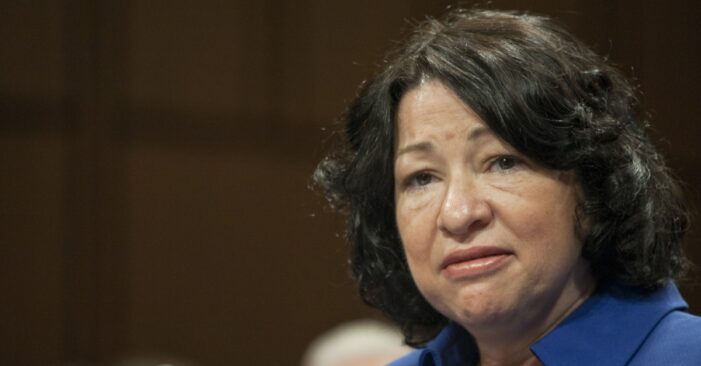US Supreme Court Nominee hearing Sonia Sotomayor July 13, 2009 in Washington, DC (Shutterstock)
By Mackenzie Long, Teen Vogue
The Supreme Court has always been shrouded in mystery and essentially free from accountability. That’s largely by design. Oral arguments, final decisions, and written orders are the only aspects of justices’ work that are regularly made available for public consumption. The recent leak suggesting SCOTUS might strike down the constitutional right to an abortion was in part so stunning because it was the first time in modern history a draft decision has been made public while a case is still pending. The justices ordinarily deliberate privately, and they almost never give interviews to the press — especially not about cases still under review.
The idea is that by insulating the justices from the public, and from political debate, the better they’ll be able to stay above the political fray and act as fair arbiters of the law. If justices act as — or are seen as — merely politicians in robes, then the whole judiciary falls apart.
Unfortunately, that may already be happening. President Trump vowed during his campaign to put justices on the bench that would overturn Roe v. Wade. So what would it say about the Court’s ability to stay out of politics if it does just that in only the second full term in which all of Trump’s appointees are on the bench? And what does that say about the Trump appointees who went on the record during their confirmation hearings to suggest they would not overturn Roe?
Some longstanding aspects of the high court are also undermining its credibility. Justices don’t abide by an ethics code — unlike the rest of the federal judiciary — which means there is no mechanism to check bad behavior. In fact, only once in U.S. history has a justice been impeached. Additionally, in recent years some of the conservative-leaning justices have also grown more comfortable with doing their work with as little transparency as possible, handing down controversial opinions without any explanation whatsoever through the court’s “shadow docket.”
All of this is incredibly alarming. But it should come as no surprise to anyone who has been listening to the voice of one person who has been trying to get all of us to wake up to what’s happening with the Supreme Court: Justice Sonia Sotomayor.
When she joined the court in 2009, Sotomayor became only the third woman ever to hold the position of justice, and the first Latina to do so. As the most liberal member of the Court (which was true even when Justice Ruth Bader Ginsburg was still on the bench), Sotomayor has always been in the minority with her other liberal-leaning colleagues. The arrivals of President Trump’s appointees — Justices Neil Gorsuch, Brett Kavanaugh, and Amy Coney Barrett — mean the Supreme Court is more conservative today than it’s been since possibly the 1930s.
As the Court has moved further and further to the right, Sotomayor has made it her mission to shine a bright light on the effects her conservative colleagues’ decisions will have on everyday Americans. She doesn’t mince words or pull any punches. When the Court does something she sharply disagrees with, she says so in striking dissents that provide a real-world perspective usually missing from the Court’s musty chambers.
For instance, when SCOTUS ruled in 2016 to allow the use of evidence obtained during an illegal police stop, Sotomayor wrote in her dissent about the experiences of those “subjected to the humiliations” of being stopped without any basis for suspicion. She cited W.E.B. Du Bois, James Baldwin, and Ta-Nehisi Coates to illuminate the indignity of always being subject to police searches, and the history of Black and brown parents giving their children “the talk” about interacting with officers of the law.
She also knows how to grab headlines, reaching for language that is sticky and capable of shaping debate in terms that reporters and readers can easily understand. During oral arguments in Dobbs v. Jackson Women’s Health Organization, the case in which SCOTUS might overturn Roe, Sotomayor made clear what would happen if justices eliminated the constitutional right to an abortion. She noted how it would further destabilize trust in the Court at a time when a majority of Americans now think justices are motivated by their political preferences, not the law. Sotomayor pointed out that states are passing stricter abortion laws specifically because they expect the Court’s new conservative supermajority will approve. Sotomayor posited, “Will this institution survive the stench that this creates in the public perception that the Constitution and its reading are just political acts?” That one sentence shaped the entire news cycle following the hearing, making the story of the day about whether the Supreme Court was willing to undercut its own authority in order to force pregnancies.
Her other liberal-leaning colleagues, justices Stephen Breyer and Elena Kagan, have also delivered strong dissents in the face of the Court’s rightward turn. But Sotomayor is unique in her dogged commitment to rectifying some of the Court’s long-standing institutional flaws too. Since the Court has limited capacity and four justices have to vote in favor of taking up a case, thousands of petitions are ignored by SCOTUS each year — often without public comment from any of the justices. Not so for Sotomayor.
More often than her colleagues, she dissents publicly when the court chooses not to hear a case, usually lifting up those cases that involve individuals suffering at the hands of our imperfect, sometimes unjust legal system. Last year she weighed in on a petition from an immigrant facing deportation to Haiti, where he could be subject to “extreme physical punishment, torture, and isolation” for having a mental illness. Sotomayor wrote, “All he asks is the small grace, to which he is legally entitled, of being allowed to remain in the country while he pursues his substantial claims for relief. Because I would grant him that opportunity, I dissent.”
As the conservative Supreme Court has used the shadow docket more in recent years, manipulating a long-standing, routine judicial mechanism by which justices can avoid accountability for their decisions, Sotomayor hasn’t held back from calling out the abuse of process. In September, for example, SCOTUS allowed Texas’ abortion ban, S.B. 8, to take effect using this mechanism, which meant it didn’t have to publicly share its reasoning. All four dissenting judges filed opinions nonetheless, with Sotomayor writing, “The Court should not be so content to ignore its obligations to protect not only the rights of women, but also the sanctity of its precedents and of the rule of law.”
Through her dissenting opinions, Sotomayor is leaving behind bread crumbs for future advocates and justices in the hope they will use her arguments to right the wrongs of the current court. This is how justices try ti wield some influence, even in the minority. But it’s remarkable the degree to which Sotomayor makes use of it. She’s essentially laying the groundwork for any rights taken away on her watch to be restored down the road.
Sotomayor also seems to be speaking directly to the public, hoping to spur action in the present. The ways in which she shapes her dissents — with language that is easy to understand and even easier for phrasing headlines — seems intentional. She wants her words of caution and even calamity to reach those who might be impacted and, perhaps more important, those who are willing and able to do something about it.
At an event in September, Sotomayor warned an audience of law students about what’s to come from the conservative Supreme Court. She said, “There is going to be a lot of disappointment in the law, a huge amount. Look at me, look at my dissents.” She also commented on S.B. 8, saying, “You know, I can’t change Texas’s law, but you can, and everyone else who may or may not like it can go out there and be lobbying forces in changing laws that you don’t like.”
She’s right. The Supreme Court is already enabling the elimination of reproductive rights, and if Justice Alito’s draft opinion is any indication, they might go so far as to eliminate the right to an abortion entirely. The conservative majority is also unlikely to stop there. The rights of voters, LGBTQ+ people, people of color, and more all hang in the balance, and the arrival of Justice Ketanji Brown Jackson won’t change the conservative court’s current trajectory.
But the American people can, and that’s what Sotomayor has been saying all along. I’m not suggesting we make her the next “Notorious RBG” or rolling out the tote bags, mugs and merch with her face on it. To the contrary, our democracy (and planet) can’t afford superficial and capitalist-fueled fixations with public officials that stop short of meaningful action. What we do need is a broader understanding of what the conservative Court is doing, and what needs to be done to stop it from inflicting serious harm on our country and communities. Sotomayor is serving that up on a silver platter; we just need to join her at the table.





